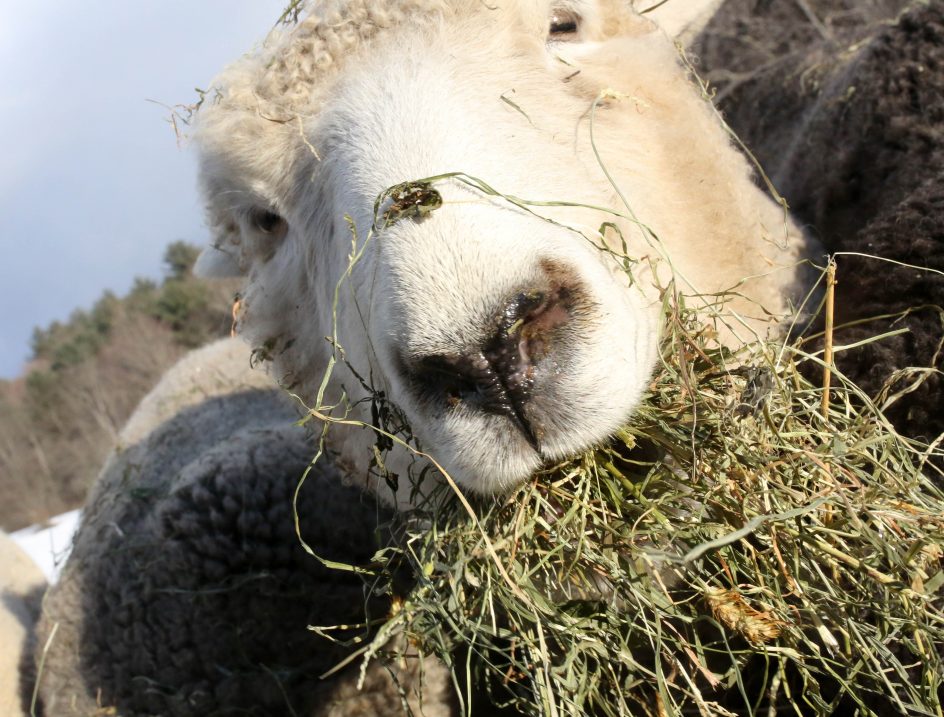
I got into the hay feeder with Rosemary today, photographers have to move, even in winter. She was loving her second cut hay so much she gazed curiously at me and my camera, but didn’t move.
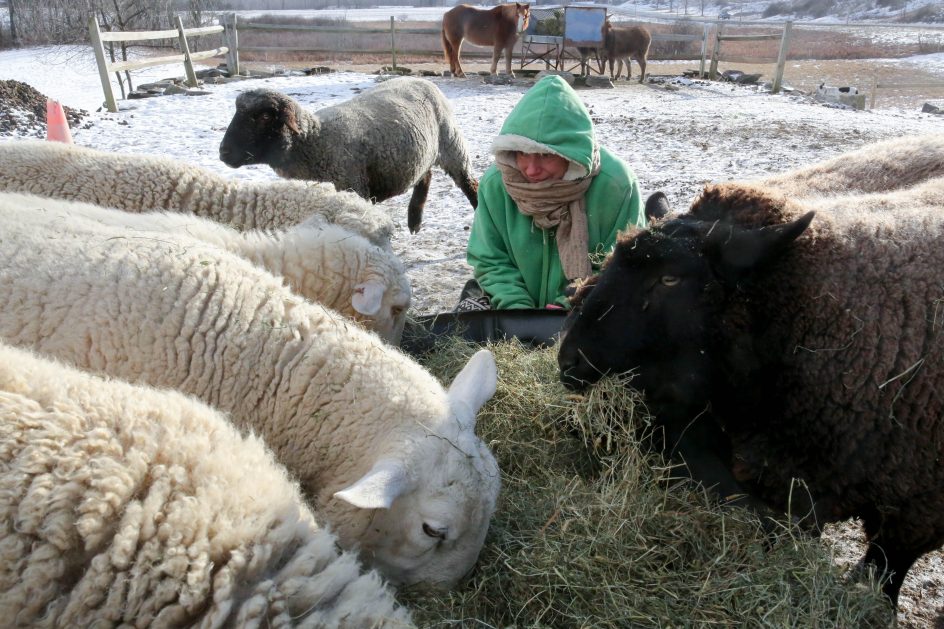
Maria has always intuitively understood what it took me much longer to learn. The intelligent and appropriate use of food is central to establishing trust, communications and safety with almost every animal, especially dogs, donkeys, sheep and horses.
Food is the gateway to understanding and communications. If you pay attention or follow the veterinary literature about pets (I do), you can see that most animals, especially pets, are grossly overfed. In fact, overfeeding is the leading cause of death among domesticated dogs, according to the American Veterinary Association.
Dogs are give too much food, “gourmet” foods that are often too rich and unnecessarily costly. Dogs are given fatty, expensive gourmet treats they don’t need and that is not healthy for them. Simple basic foods like Science Diet, a food most veterinarians use at home. Dogs do very well on this food and it is almost universally recommended by vets, but since they are not expensive or marketed as gourmet specialty foods, many people prefer the exotic premium, and dramatically more expensive dog foods.
They can’t do enough for their dogs, which is why overfeeding kills so many of them.
In general, we give our pets what makes us feel good, not what they need. Dog food makers have learned to play on the neediness and insecurity of pet lovers. Few farmers overfeed their animals, they can’t afford to. I have learned a lot from farmers about the difference between what dogs need and what we think they need.
When we get a dog, I will often sit on the floor next to them while they eat (being careful to know the breed and nature of the dog). I want them to associate me with sustenance. We love to think our dogs love us dearly because we are such fine and loving creatures, but the truth is that animals love who feeds them, and will bond almost instantly with them, no matter what they are like.
I have never been bitten or even nipped by one of my dogs, a record I intend to preserve.
We make it a point to be near our animals when they eat, they associate us with good things and come to trust us. Seeing Maria sit with the sheep every now and then while they eat – and how accepting they are with her – says much about her very special instincts for connecting with animals.
On a farm, trust is a serious matter. I’ve had to read into these ewes and pull out stuck babies while they hold still, I’ve had to walk this big pony back into the pasture several times when a broken gate flew open or I left a door open carelessly. It is nearly impossible to get donkeys to do anything they don’t want to do if they don’t trust you, and even then, it is not simple.
The key to food is not pressing too much of it on our animals, but letting them associate us with their food. Their life depends on food, and they will attach to whoever provides it. I remember flipping Frieda around, it took a year and a lot of beef jerky, she eventually decided it was better to get a lot of beef jerky than kill me.
Maria’s love of animals is very intuitive, rather than learned. She knows how to be with them, talk to them, listen to them. She is frequently a guest at their dinner table. i have learned the same thing. Food is the gateway to understanding and listening to animals.
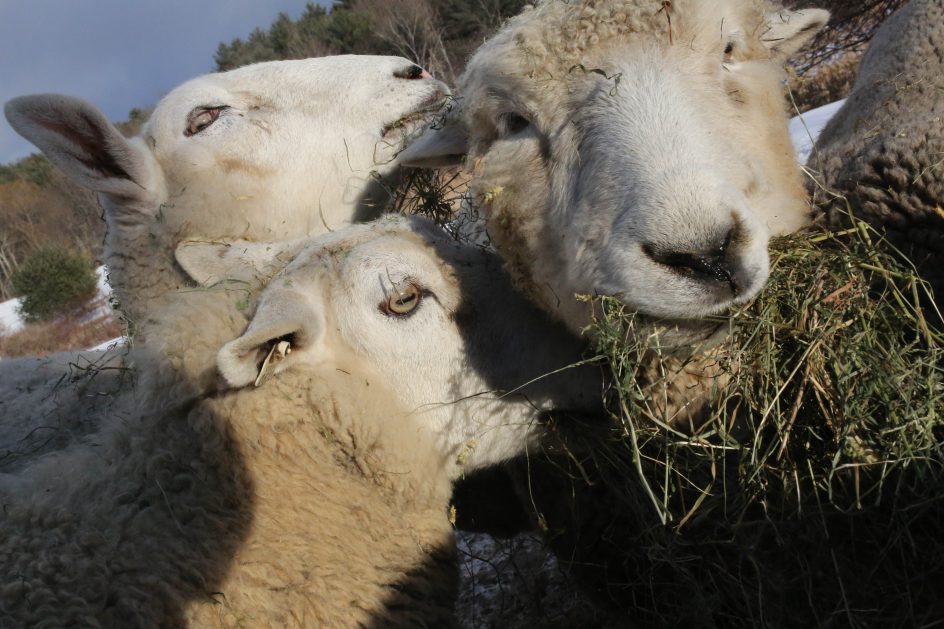 Liam, Zelda, Rosemary: Second Cut
Liam, Zelda, Rosemary: Second Cut
The amount of hay cuttings in a given season depends on a number of things – rain, heat, geography. Farmers and animal lovers have been arguing for years about whether there is much of a difference between first and second cut (or even third or fourth cut, not often available up here), and I have my own opinions about it, having been buying, tasting and observing animals and their health and diet for more than a decade.
First cut is generally the first time hay is cut, it starts growing in the field in the Spring.
Farmers mow (cut) the hay down as the hot and dry weather of the summer comes. The green cut hay is permitted to dry out in the fields and under a warming sun and is then baled – either in smaller, square bales or the much bigger round bales – and transported and sold.
Cows invariably get round bales of first cut, left out in the elements. Cows are not fussy about what they eat. They are generally given grain as well.
First cut hay is grass heavy and doesn’t have a lot of legumes, such as alfalfa or cover.
In late July or August, weather permitting, this second stand (a/k/a second cut) is harvested, dried and baled. Usually, second cutting is a lighter harvest that yields fewer bales than first cut, when the grass is going sort of wild, given rain and sun in the right mix. Second cut smells sweeter and is richer in nutrients. Also calories.
First cut hay is coarser than second cut, this is because the spring growth (rain, etc.) leads to thicker stems and stalks and heavier leaves. Second cut hay has a finer texture and usually, a greener color and heavier leaves. It is more dense, the leaves are more tender and healthier, especially in protein. It is also somewhat more expensive, anywhere between 50 cents and a dollar a bale, depending on where it is grown.
Donkeys and sheep are generally fed first cut, they are hardy and adaptable, they will eat almost anything green, second cut hay is a luxury for them, sort of like Thanksgiving Dinner. If you have a horse or pony like Chloe, you have to limit the amount of green grass, and especially, second cut hay. Equines can founder – a serious and painful wasting disease – or gain too much weight, or eat too much sugar, prevalent in rich green grass in the Spring.
At first, like many newcomers to farms and animals, I (I dislike the term “gentleman farmer,” as there is nothing inherently privileged or well-mannered about someone just because they own a farm as a second home) fed all of my animals second cut hay all winter until shocked farmers straightened me out. “It isn’t Thanksgiving every day,” they said, almost every one of them.
Generally, we feed all of our animals first cut and in limited amounts. Our animals – 10 sheep, two donkeys, one pony – generally are fed about a bale of hay a day altogether, or a bit less – one-third around 8 a.m., one-third around 3 p.m. They share the feeders, moving back and forth from one to the other. Generally, the equines end up eating in one feeder, the sheep in another. The equines eat much more deliberately and chew much more thoroughly than the sheep, who grind the grass with their back teeth and nearly inhale it.
In mid-winter, when there is a strong wind or heavy snow or single digits, we break out the second cut, it is believed to give them more energy and strength to ward off the cold. We also have heated water at all times in cold weather, the water itself warms the animals and they drink a lot of it when it is cold.
This year, we purchased 120 square bales of first cut, 20 bales of second cut. They hay cost between $4.50 and $5.50 a bale.
I am not an animal nutritionist, but I notice a marked change in the way animals eat first or second cut.
Second cut clearly smells better and tastes better for them, they devour it, they practically climb all over one another, as you can see above. First cut is eaten in a much calmer, quieter way.
When we are putting second cut hay out, I hold Red back, the sheep will uncharacteristically pay little mind to him, or to us. That’s how I know it is different. They just gobble it down. We are feeding second cut today and tomorrow, it’s supposed to be especially cold, and then warm up on Tuesday a bit.
Back to first cut. I took some photos today which show how much the sheep love second cut hay. I hope they enjoy it, it isn’t Thanksgiving every day.
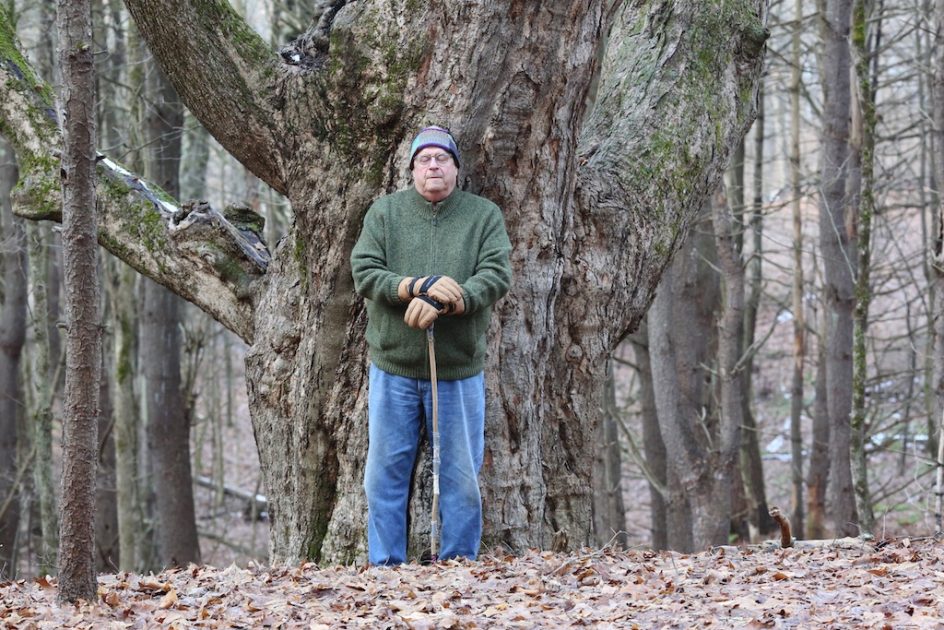
How old am I, anyway? What can I do and what can’t I do? What should I do and what shouldn’t I do? Lots of people – doctors, friends, insurance companies, nurses, busybodies on Facebook – have lots of advice for me, much of it contradicting the other. I am amazed at how many experts there are in such a confused and polarized world.
It is, of course, up to me. But it is important to see the world clearly as one ages, and to neither be too cautious or too reckless. A trip to Calcutta with Maria one day seems to exist right on the line. And I will be truthful, it breaks my heart a bit to think there are places – any places – I could not go with Maria.
There hasn’t been one yet.
Maria is going to Kolkata (formerly Calcutta) India next month and we have both agreed it is not a good idea for to accompany here, especially the first time. This your circus, I told her, not mine. Maybe next year, if she chooses to return.
We have been watching hours of videos from Kolkata, some horrifying, some exhilarating. The images make me want to go. Very much. I can only imagine the photographs. It looks (and I’ve also read) that this city is one of the most fascinating places on the earth, so rich in color, history, culture and poverty.
I’d love to go with my big camera.
But there are other voices in my head, and I need to be honest about them. I’m not sure I can go to Kolkata or should.
I have diabetes, although it is under control. And I have heart disease. I had open heart surgery a few years ago, and have also have recently been diagnosed with angina, a type of chest pain and pressure that results in reduced blood flow to the heart, occurring especially when the heart is strained.
Kolkata, like much of India, is a wonderful, culturally rich, exotic, overcrowded, and in parts, horrifically impoverished place. It has 30 million people, many of them sick and poor to the point of starvation. Tens of thousands of people live right on the city’s vast garbage dump and there are thousands of children offered up for sale in the notorious Red Light district.
Maria is going to the city to teach some of these liberated children how to sew and make potholders and other things that can bring them a different kind of income and security.
There is the bad.
Maria has been getting shots for weeks now, including Malaria, and Tetanus and Hepatitis A and B, Typhoid Whooping Cough, and Flu, she is bringing a prescription anti-biotic packet to ward off the infections many visitors instantly acquire just be breathing the air, fouled by vehicle pollution and thousands of daily human cremations. Any one of these things could cause me serious trouble.
There there is the good.
Kolkata is famous for its wonderful street food, but there are lots of worries for people with chronic conditions. I am prone to stomach viruses, and would not care to get one in India. I’m not sure how my angina would fare there, either the heart is affected by many factors – exercise, humidity, walks uphill, stress, temperature and some food.
Everyone by now knows about the water.
Here, I am very careful about what i eat, that is, in part, why my blood sugar is good. There, I wouldn’t even know what I was eating much of the time. And I would definitely want to sample some of that food. I wouldn’t care to be imprisoned in a hotel, if I went, I’d want to wander and explore and take pictures.
I think my friends – many of whom are just old fussy Grandmas – would sound the alarm and say no. I have a young friend who is puzzled that I’m even thinking about it. Go, he says. Maria says yes also.
Is Kolkata really the place for an older man with diabetes and heart disease? I take a number of medicines by mouth every day, and a couple by needle. I would have to take these fresh (and often refrigerated) supplies with me everywhere I went, and I would have to carefully research the help that would be available if and when I need it.
As is, I’m afraid to call my cardiologist, they are quick to rush people to emergency rooms. I’d love to photograph an emergency room in Calcutta, do I wish to be rushed to one there? I’m sure there are good doctors and hospitals there, but I suppose I do feel more vulnerable than I once did.
I am not a ride-around person, if I were in Kolkata, I would walk miles and miles with my camera bag until I could not walk any longer. I know that about myself. I do not really know how to be all that sensible. If I did, I wouldn’t be sitting on a farm in single digit temperatures for weeks and months on a farm and loving every minute of it.
I am no snob, I would love India, and I believe I could go there. But I’m not certain. Maria and I would love to explore a place like India together. But we could also go some place a little simpler – New Mexico, Florence. It is an important passage when someone says they are too old to go to a wonderful place like India with their spouse or partner.
As of now, I am leaning towards going. I’d have to prepare and take precautions – one camera only and two lenses! Getting older has no limited me, but opened many new doors for me. I’d like to keep it that way a good deal longer. The answer right now is that I do not know, although I realize that if you have to think so much about it, that’s probably a bad sign.
So I’ve got to do a bit more research, and some more thought. Maria will have a better idea when she returns. Maybe I will also.
I am happy to be older, I am better at being old than being young. It has turned out to be a rich and rewarding time for me, a time of some wisdom and experience. I guess this is one of those times when I have to put both to some use. My heart is perhaps a bit under pressure these days, but it still works fine. It hasn’t spoken up yet about going to India.
I think it will tell me what to do.
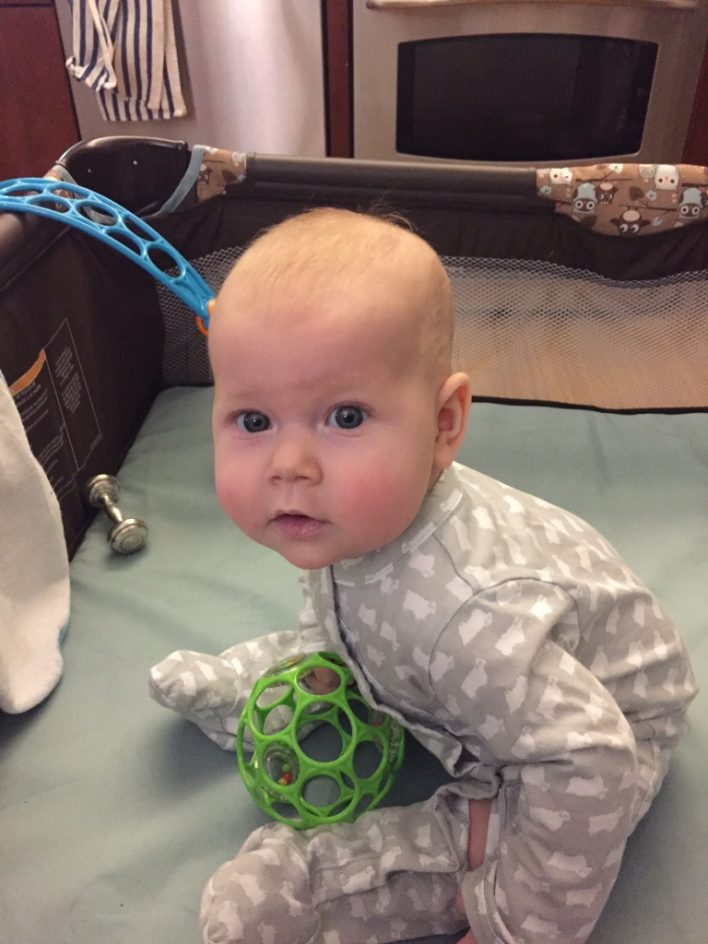
The first sit.
Yesterday, I send Robin a voice message, a message and a step towards figuring out how we will stay in touch these next few months when we are not likely to see one another or be in the same space. After she got my message and showed it to Robin, my very busy but thoughtful daughter Emma jumped in on her end. Emma set up a Facetime chat between Robin and me on our Iphones, each of us using new technology to bridge a gap that was once not bridgeable.
When I answered the call, Robin was staring at me and I was staring right back.
Robin looked at me (and also Fate, who jumped into the picture, naturally) and stared for a good long time.
She smiled a bit, although whether she recognized me or was just laughing at me was not clear. She is quick to laugh, I see. Mostly she was amazed at the sight of this strange man and dog, both making noises at her.
Red was above all of this, although Maria jumped in.
I’ve dissed the idea of a Facetime relationship, but Emma ignored me and I liked it. It was fun and I could see the possibilities. You don’t have to be in the room to have a relationship.
Emma and I are both working hard to keep me in Robin’s life, and it is fun, and I am enjoying this dialogue with my daughter every bit as much as I am enjoying Robin. We are getting closer also. Such riches.
So here is this very young creature and her much older grandfather, hundreds of miles away, and we are finding ways to connect with one another, both using tools that did not exist a few years ago. I record my messages on the Iphone, upload them to SoundCloud, an audio processing site and then publish them on the blog. I can also e-mail them.
Robin was transfixed.
Finally, I get it, it is a creative challenge, I can work with it. A few minutes after we got off the phone, Emma messaged me this photo, it was, she said, the first time Robin has ever sat up. Another chapter begins. I suspect she will be reading by Easter.